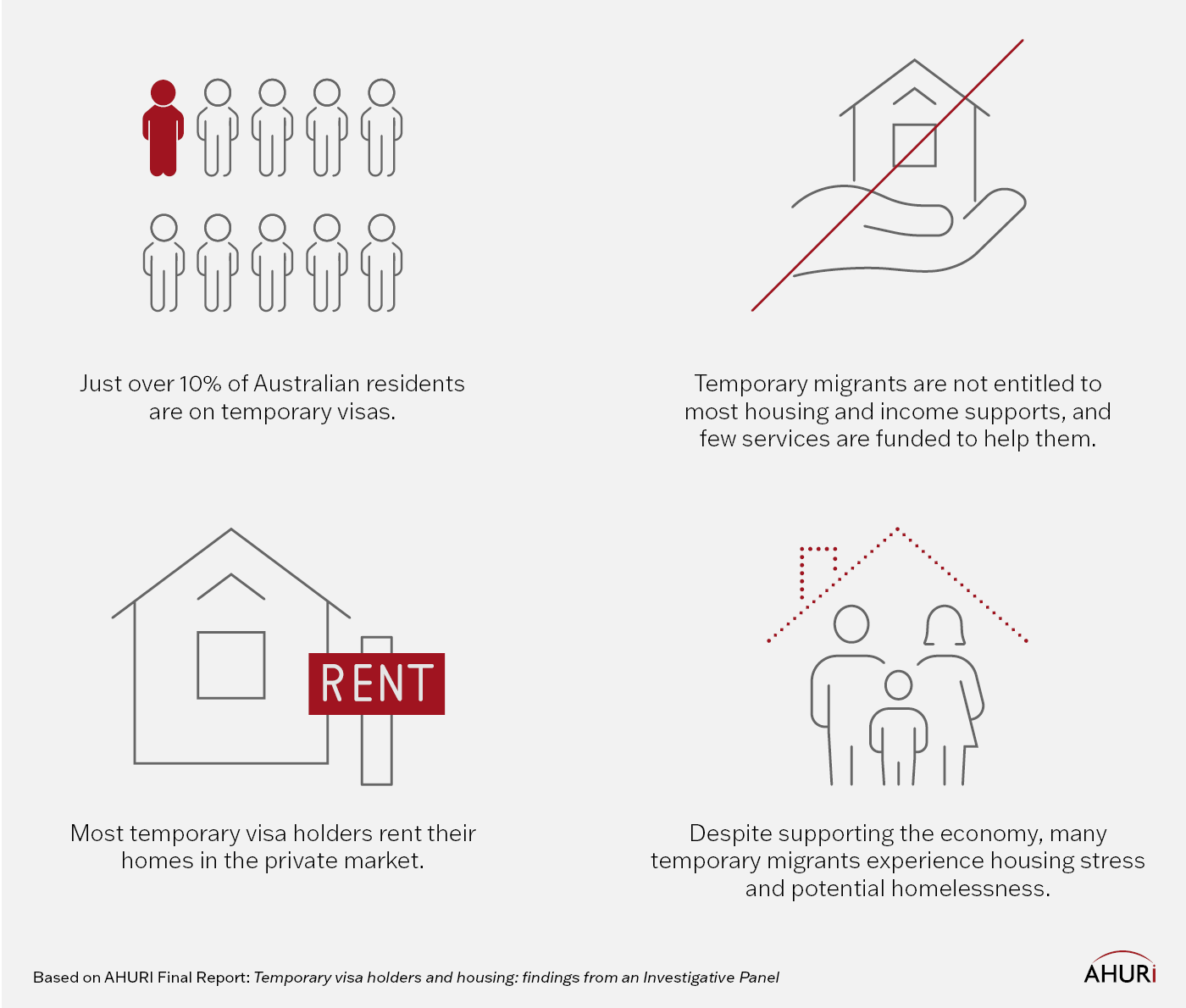What this research is about
This research explores the impact of Australia’s housing crisis on temporary migrants. It examines how housing challenges affect temporary migrants’ wellbeing, their ability to contribute economically, and the distinct housing issues they face.
Why this research is important
More than 10 per cent of Australian residents are on temporary visas and these migrants play an important role in the country’s economy. Despite this, the impact of the housing crisis on this group receives little attention. Temporary migrants are also often blamed for worsening the crisis, despite being ineligible for most housing supports. This research delves into how these circumstances impact temporary migrants and how systems can be improved to boost their wellbeing and economic contribution.
-
At a glance
-
Key findings
A growing cohort
There are now more than 2.8 million people in Australia on temporary visas, equating to 10.5 per cent of the population.
Some 1.1 million temporary visa holders are New Zealand citizens or tourists. This research focuses on the remaining 1.7 million temporary visa holders.
Lack of supports
Temporary migrants have little or no access to social housing, income support, or other government services, making them more vulnerable to housing precarity. Ineligibility for social and health supports can lead to entrenched disadvantage, and potentially to exploitation, abuse and homelessness.
Support services often fall to cultural and religious groups and some service providers who stretch their capabilities.
Women and children who experience family violence are particularly vulnerable as temporary migrants.
Poor housing conditions
An estimated one in five temporary residents live in overcrowded situations.
Pacific Australia Labour Mobility (PALM) workers, working holiday makers and skilled visa holders in rural and regional areas face particular difficulty. Housing is often costly or scarce in these areas, and many visa holders rely on their employer providing accommodation.
A cohort unprepared for Australia’s rental market
Most temporary migrants live in private rental properties, but many lack information about the market before they arrive and do not know where to go for help if they need it. A lack of rental history is also an issue in gaining suitable accommodation in a very competitive market.
-
Policy actions
Expansion of data collection
More extensive, objective data on temporary migrants’ experience of housing and related issues would help fill an existing blind spot.
Governments could also expand the range of data that service providers are required to collect.
Increased coordination of policies and practices
Making government oversight and regulation of temporary migrants less fragmented would reduce barriers to action.
Closer collaboration across the tiers of government, agencies and community groups assisting temporary migrants could produce more effective interventions that support vulnerable migrants in times of need.
Educate and inform new arrivals
Better and more formalised information channels could be established to inform temporary migrants of the housing situation in Australia. This should involve government, education agents and education providers.
Government agencies could also cooperate with NGOs working in the humanitarian space, to benefit from their experience in helping temporary migrants settle.
Housing provision and support
Temporary migrants are currently limited in their eligibility for social housing and homelessness services.
Governments could move to providing transitional housing for three months, to assist temporary migrants on arrival.
Funding homeless services for temporary migrants in crisis could benefit service providers, who report stress at being largely unable to help this group.
Rental reform
Private tenancy law reforms that recognise the greater diversity of renters would benefit temporary migrants.
National housing reforms introduced in 2023 provided better consistency across state rental laws, and improved security for tenants, but a more comprehensive system is needed.
Encouraging alternatives to state housing
Responsibility for housing temporary migrants could rest with the government departments responsible for the different visa groups rather than with housing authorities.
This could open the way for educational providers to play a stronger role in supporting international students, for whom housing is a major issue.
Reforming employer-provided accommodation
Agencies responsible for particular visa classes could be more active in monitoring and regulating hosted accommodation, whether this be working holiday makers or PALM workers living in employer-provided accommodation, or international students living with a family.
Enhancing cultural and community support options
Services that support humanitarian entrants like refugees could be made available to temporary migrants with additional resourcing.
Boosting housing supply in regional areas
Governments could intervene to incentivise building in regional areas, which often have active PALM programs or provide educational programs for international students.
-
Research design
The main research approach for this project was two Investigative Panels convened with experts from the migration, housing, educational, support service and voluntary sectors. Investigative Panel discussions were supported by a targeted literature review and descriptive analysis of data. Focus groups and interviews were held with government officials, service providers and temporary visa holders.



